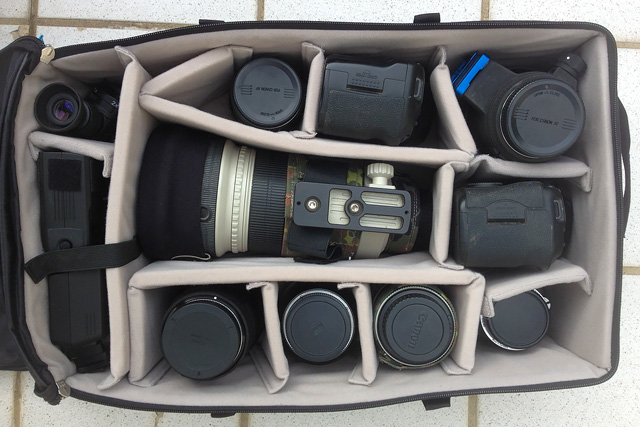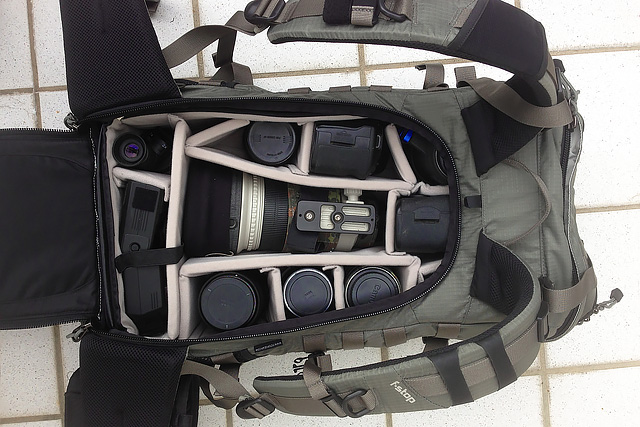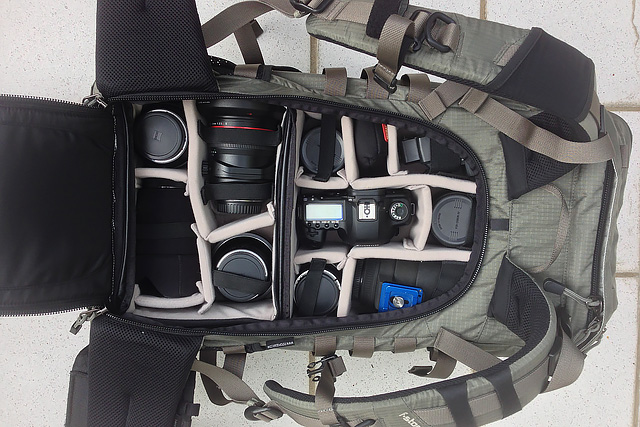reviews
f-stop gear satori exp
F-stop Gear is a fairly new U.S. based manufacturer of high-end bags and backpacks for outdoor photographers. This company is declaring to be guided by requirements of outdoor photographers and is specialised in production of carrying solutions for their equipment.Like ThinkTank Photo that is more widely known and became very popular in the recent couple of years for its very versatile and innovative products, F-stop Gear was established by professional photographers with a mission to develop and produce bags and backpacks that would satisfy the needs also of professionals. However, while ThinkTank Photo has mainly sports, events photographers and news reporters in focus, F-stop Gear creates its carrying solutions for those who work mainly in wilderness. For the time of writing I know only one more company — Gura Gear — that designs its products mainly for this target group. However, their bags and backpacks are more suitable for serious amateurs and professionals who don't carry very heavy equipment and don't normally spend much time in extreme outdoors.
Other companies, including the market leader — Lowepro — make a vast variety of bags, pouches, backpacks, etuis for any kind of devices — from point-and-shoot cameras to professional super telephoto lenses — and for carrying in various situations — on the street, at concert, at beach, etc. The same applies also to Kata and Tamrac. Some manufacturers, such as Clik Elite, Mindshift Gear, create quite innovative bags that are supposed to be used by “adventure” photographers. In fact, they are more suitable for sports photography and, if outdoors, then as photo daypacks during short excursions or activities like rock climbing, cycling, skiing, etc.
In the following table I have summarised the deficits and advantages of all products of other companies that can be considered as alternatives to Satori EXP. Of course, this list may be incomplete because there could be backpack manufacturers that I don't know or new products and companies may have appeared after this review was finished. I didn't include any products of ThinkTank Photo into my analysis because I personally don't see any suitable for nature photographers although they make otherwise great bags and backpacks for professionals in other areas of photography.
| Product | Pros | Cons |
| Gura Gear Bataflae 32L | fairly large, fairly lightweight | only frontal access, no top access, non-customisable space, too small for lenses with focal length above 600 mm (or with tele-converters attached), suitcase-like shape and harness not optimal for long carrying, poor extensibility (limited possibilities for attachment of external add-ons). |
| Gura Gear Uinta | rear side access, fairly lightweight, through insert modules customisable space, harness and shape suitable for long carrying | no top access, too small for lenses with focal length above 300 mm, too little space for non-photographic gear and items (cloths, food, etc.), poor extensibility (limited possibilities for attachement of external add-ons). |
| Clik Elite Volt | self-standing, top access, fairly lightweight, harness and shape suitable for long carrying | front access, too small for lenses with focal length above 300 mm, too small for carrying many equipment items, too little space for non-photographic gear and items (cloths, food, etc.), poor extensibility (limited possibilities for attachement of external add-ons). |
| Clik Elite Pro Elite | top access, fairly lightweight, harness and shape suitable for long carrying | front access, too small for lenses with focal length above 300 mm, too small for carrying many equipment items, too little space for non-photographic gear and items (clothes, food, etc.), poor extensibility (limited possibilities for attachement of external add-ons). |
| Clik Elite Contrejour 40 | top access, fairly lightweight, harness and shape suitable for long carrying | front access, too small for lenses with focal length above 300 mm, too small for carrying many equipment items, too little space for non-photographic gear and items (clothes, food, etc.), poor extensibility (limited possibilities for attachement of external add-ons), too bride colour. |
| Lowepro Rover Pro 45L | harness and shape suitable for long carrying, fairly lightweight, top access, space customisable through module inserts | frontal access, too small for lenses with focal length above 300 mm, too little space for non-photographic gear and items (clothes, food, etc.), few internal modules, colour not suitable for camouflage |
| Lowepro Pro Trekker 600 AW | harness and shape suitable for long carrying | suitcase-like shape, only front access, too small for lenses with focal length above 500 mm, no space for non-photographic gear and items (clothes, food, etc.), poor extensibility (limited possibilities for attachement of external add-ons), non-customisable space. |
| Lowepro Flipside 500 AW | harness and shape suitable for long carrying, rear access | too small for lenses with focal length above 300 mm, no space for non-photographic gear and items (clothes, food, etc.), poor extensibility (limited possibilities for attachement of external add-ons), non-customisable space. |
| Lowepro Pro Vertex 300 AW | harness and shape suitable for long carrying | suitcase-like shape, only front access, too small for lenses with focal length above 300 mm, no space for non-photographic gear and items (clothes, food, etc.), non-customisable space. |
| Tamrac Expedition 6x | harness suitable for long carrying | suitcase-like shape not optimal for long carrying, only front access, too small for lenses with focal length above 300 mm, no space for non-photographic gear and items (clothes, food, etc.), poor extensibility (limited possibilities for attachement of external add-ons), non-customisable space. |
| Kata PL-PV-610 | harness suitable for long carrying | only front access, too small for lenses with focal length above 300 mm, no space for non-photographic gear and items (clothes, food, etc.), poor extensibility (limited possibilities for attachement of external add-ons), non-customisable space. |
| Kata Pro-V-410 PL | harness suitable for long carrying | only front access, too small for lenses with focal length above 300 mm, no space for non-photographic gear and items (clothes, food, etc.), poor extensibility (limited possibilities for attachement of external add-ons), non-customisable space. |
| Mindshift Gear rotation180° Professional | harness and construction suitable for long carrying, rear access, customisable space | too small for professional photo gear and for outdoor equipment, usable only as daypack, poor extensibility (limited possibilities for attachment of external add-ons). |
The manufacturers of carrying solutions for photographic equipment seem to copy the mistakes of each other in their products that they present as backpacks for outdoor photographers and stick to the same wrong concepts, overseeing the reality of outdoor life and work. The three most important deficits that almost all photo backpacks have are:
- Too small size to accommodate the complete equipment of a nature photographer:
Almost all such bags are too small for super telephoto lenses. Apparently, the manufacturers want them to fit the size limits for carry-in luggage allowed by airlines. According the rules the length of a bag shouldn't exceed 55cm. Due to padding, the internal length wouldn't then be only around 50cm. This could be enough for a 600mm or 800mm lens with reversed hood. However, this is not how photographers carry the lenses in the field; the lens has to be in a ready-to-shoot state — with hood on and mounted on a camera. Sometimes, a teleconverter goes between camera and lens. To provide enough space for this setup, the bag has to be at least 80cm long! Besides a large telephoto lens a photographer would usually carry 3-5 further lenses, 1-2 flashes, second camera body, flash brackets, other technical stuff, such as spare batteries, remote triggers, etc. It looks like there is no photo backpack on the market this all would fit into. - No or not enough space for other items than photography equipment.
Apparently, a typical “nature photographer's backpack” is supposed to contain nothing else than photo equipment: basically it is a soft-shell “suitcase” with very thick padding and a carrying harness. It has a volume of maximum 30l and weighs at least 3kg; although it is heavy even when empty, there is no space in it for equipment, tools and utilities, clothes needed outdoors as well as water and food. My first backpack — Lowepro Vertex 300 AW — was like this. I still own it but use very rarely. I always wonder what the designers of such bags are thinking: Do they, for instance, mean that a photographer who spends days outdoors, in forests and mountains, doesn't need to eat and to drink? - Poor extensibility and customising:
Most photo backpacks offer too few attachment points for additional pockets and pouches. Therefore you can't extend its volume by putting those items into external add-ons that don't fit into the backpack. Even if front and side pockets exist in such backpacks, they are either too small or too flat.
There are also other strange design deficits in photo backpacks that are not so important as the above mentioned three but still quite annoying. For instance, to access the content of a typical photo backpack you have to open a large lid on the front — like in a suitcase. Before that you have to put the backpack on earth back side down — so that it will be lying on the carrying harness. If the earth is wet or there is wet grass, and you have done it couple of times, the side of the backpack that you put on your back will get dirty and wet. Some manufacturers seem to have recognised this design mistake and make their new backpacks with an opening on the back side, so that the backpacke will be lying on the front side, when opened.
In almost all photo backpacks there is no way to quickly access the camera that is usually inside the backpack, among other equipment items. To pull it out you have first to put the backpack somewhere in a horizontal position and to open the lid. This all takes some time that a nature photographer often hasn't. As a result, when I am carrying such a bag, I have to carry the camera on a shoulder or in my hands, to be able to use it quickly. The issue of quick access is somewhat better solved in the bags of Gura Gear — Kiboko and Bataflae — that have two front lids which can be opened separately. A better solution would be to have an option to access parts of the bag content through its top. All trekking rucksacks have this construction, but for some reason most manufacturers of photo backpacks don't adopt it in their products. An exception may be backpacks for large telephoto lenses made by Kinesis, Lowepro, or a German company — Koeing (see also the review of Yellow Moon YM-902). However, they have a very specialised design and aren't suitable for carrying other equipment. Of course, one can use a normal trekking backpack with inserts for photo equipment — like those that are made by Koenig, Fjälräven, Mountainsmith — or just by putting every equipment item into it in a separate pouch (as it was discussed in the review of Golite Jam 2). This way you can achieve the most flexible use of the volume, but the access to the content will be more difficult.
real-life requirements for a backpack of a nature photographer
The most important qualities that a nature photographer's should have are in my opinion: 1) minimal weight with adequate large volume; 2) carrying comfort; 3) quick and easy access to the content.
A nature, particularly a wildlife photographer, uses a lot of heavy equipment that has to be transported in a very difficult terrain at daily walking distances of several dozens of kilometers. Here is, for instance, what I need to carry in my backpack all day long during my usual photographic one-day excursions:
- 1 or 2 camera bodies — up-to 2kg
- super telephoto lens — up-to 4kg
- 2 teleconverters — 0.6kg
- wide angle lens — 0.8kg
- 35 mm lens — 0.7kg
- 85 mm lens — 0.7kg
- tripod with ball head — 3kg
- 1 or 2 flashes — up-to 0.7kg
- 1 or 2 flash brackets — up-to 0.8kg
- flash and camera remote triggers (incl. cables) — 0.5kg
- batteries — up-to 0.5kg
- flashlight — 0.3kg
- food — up-to 1kg
- water — up-to 3l
- some clothes — up-to 1kg
- various small items, such as lens cleaning kit, rain protection covers, memory cards, filters, etc.
The total weight even of this “standard” set is around 20kg. Often I add a 150mm macro lens (0.8kg) and a 15mm fisheye (0.5kg). Sometimes I also take a ultra-wide angle lens (0.6kg) with me. Now and then I need a binocular — around 0.8kg. When I am going to photograph wildlife I may take camouflage net or a bag hide — around 2kg.
Of course the real load varies according to situation. Sometimes sources of drinking water are available on my route; then I don't carry so much water with me. Anyway, I almost never carry less than 15kg on my back when I am in the field — no matter, if I am breaking my way trough thick bushes or climbing mountains. A bag with a volume of at least 40l is necessary for that. Unfortunately, even backpacks of renowned brands, such as Lowepro, are very heavy due to thick padding, heavy fabric and harness construction. Most large backpacks weigh well over 3kg when they are empty. Thus the total weight of what you are carrying would quickly approach 20kg even if you have only 15kg inside.
The weight of a load that an adult person carries for a long period of time should not exceed 25-30% of his or her body weight. People under 17 years old should not carry more than 10kg. Of course, this doesn't mean that all people would be able to carry that much. Even someone who weighs over 100kg may not be strong enough to carry even 20kg. I can carry around 20kg although I weigh less than 80kg, but when I do it, it is rather an exception than a rule. However, it doesn't mean that backpacks should be designed like they usually are — to be heavy themselves and not to allow to take more than 15kg.
I am sure that my requirements are not an exception, and most nature photographers have to carry about as much. The more the lack of photo backpacks on the market that meet these requirements surprises me. At the same time many models of trekking and mountaineering backpacks exist that are perfectly designed for carrying of heavy load over big distances on difficult terrain. Certainly, any outdoor photographer would appreciate in his backpack the same qualities of a good trekking backpack:
- Low empty weight: The best trekking and mountaineering backpacks are made of high-end materials that are both, strong and lightweight. Of course, other than photo backpacks, they have no padding. In photo backpacks, however, the padding is usually too thick and too heavy, and could be made thinner and lighter. In conjunction with more lightweight shell and carrying system this would result in substantial weight reduction.
- Large volume: Trekking and mountaineering backpacks have never a volume less than 60l, and many are much larger.
- Internal space divided into compartments: Trekking backpacks have at least 2 compartments, while the best ones have 3. There is separate access to each compartment from outside, so that the content of it can be pulled out quickly. For soft, large and not very heavy items, such as sleeping bags, the trekking and mountaineering backpacks have a compartment at bottom. In the largest middle compartment heavy items and the rest of the stuff are being put. In top compartment there are items that should be ready for quick access. Ideally a photo backpack should have the same construction but with removable compartment dividers and a possibility to open the lid of the entire middle compartment completely.
- Upper compartment with top access: The top of trekking and mountaineering backpacks can be opened like in a sack. If the backpack is divided into compartments, the access to the upper one is provided through the top. Its content can be accessed easier than in the main compartment. In a photo backpack this would be the perfect place for the main camera. However, the volume of this compartment has to be adjustable to provide enough space for a camera with a large lens.
- Comfortable carrying: Anatomically fitted and padded hip belt and shoulder belts, adjustable air flow back system — many photo backpacks have all this only to a limited extent or don't have at all.
- Hydration: A bladder that takes a large volume of water and a hose that allows you to drink it on the go are a very nice feature of almost all modern trekking and mountaineering backpacks. Most photo backpacks lack it and don't even provide space for any water reservoir at all.
- Adjustable height: All trekking and mountaineering backpacks have an expansion sleeve under the top lid. With it you can increase the height if necessary and reduce it again if the backpack should be smaller. Almost all photo backpacks lack this ability. It is good that the manufacturers are attempting to keep their size within the limits of airlines. However, super telephoto lenses with attached hoods are longer than this even when they aren't mounted on a camera. Like with all equipment that a photographer uses in the field, a camera with a telephoto lens has to be assembled and ready for shooting. Then it would never fit into the backpack that was designed in accordance with airlines rules. A solution could be — to make its height expandable.
- Additional fixation points for external bags: Trekking and mountaineering backpacks usually offer many ways to attach additional bags and equipment items to them thus to extend the volume.
Of course, trekking backpacks aren't designed and manufactured for use as photo backpack. They simply lack the qualities needed for transportation of photo gear, such as impact protection and easy access to single items inside them. The use of above mentioned inserts doesn't solve the problem completely: It still remains difficult to quickly take out and to put back, for instance, lenses when you have to exchange them.
F-stop Gear appear to be currently the only manufacturer making bags and backpacks both, for carrying of large quantities of heavy photo equipment and with serious outdoor use in mind. The Satori EXP that I am going to comment in the rest of this review isn't ideal but is closer than any other backpack on the market to having met the requirements discussed above.
satori exp
Unlike trekking rucksacks where the manufacturers usually offer more than one size of each model, Satori EXP exists only in one size. It would fit people with medium back length better, and better men than women. Small or very big people may feel uncomfortable wearing it at large distances with very heavy load.
The Satori EXP like two smaller backpacks of the Mountain series — Tilopa BC and Loca — combines the traits of a mountaineering backpack with photo backpack. Basically, it is a very well made, with use of best materials, mountaineering backpack that has an opening on the back side through which the entire content of it can be accessed. Protection and the ability to hold photographic gear is provided through so-called “ICU” (Internal Camera Units) — padded soft-shell boxes of various sizes. One or more of them can be inserted in Satori EXP. The remaining space can be filled with anything that doesn't need to be carried in a protected container.
Without ICU Satori EXP is just a small rucksack suitable for short trekking for a couple of days, but too small to be used as main baggage for long ventures far from home. The manufacturer gives the following size and volume information in the description of Satori EXP:
Source: fstopgear.com

According to it, the backpack has the volume of 62l and the maximum dimensions 29.2cm x 35.6cm x 66cm. The result of multiplying these numbers will be 68.6cm3. Apparently the indicated volume of 62l can be reached when all compression belts are loosened, and Satori EXP has its maximum size. In reality, the usable volume for carrying photographic equipment is much smaller. The largest available ICU has the internal dimensions 16.5cm x 26.7cm x 45.7cm, hence only about 20l volume. When this so-called “XL Pro ICU” is inserted, very little space remains for the rest.
A 45cm long Canon EF 600mm 1:4L IS II USM without hood (or with hood reversed) may fit into it, but EF 800mm f:5.6L IS USM that is 1cm longer probably wouldn't. The same applies to the largest Nikon lenses: AF-S NIKKOR 800 mm 1:5.6E FL ED VR with its 46 cm lens may be too long while the 1.5 cm shorter AF-S NIKKOR 600 mm 1:4G ED VR should go. Satori EXP is then perfect for carrying such lenses in hand luggage on airplanes but not for use in the field because the lenses will be carried not in ready-for-shooting state.
The currently largest ICU “Pro XL” with 20l volume can accommodate about the same amount of equipment as the largest photo backpacks of other manufacturers, for example Lowepro Vertex 300 AW or Gura Gear Bataflae 32L. Interestingly, the total volume of such backpacks is indicated by the manufacturers as 30-35l — not 62l, as F-Stop Gear claims for Satori EXP.
The next picture shows an example of what I can put in the Pro XL ICU of my Satori EXP: 2 camera bodies, 1 medium sized telephoto lens (such as 2.8/300mm without hood), 1 smaller telephoto lens (such as 2.8/150mm macro), 1 small telephoto lens (such as 1.4/85mm), 1 medium wide-angle (1.4/35mm) or a standard lens, 1 small wide-angle lens (such as 3.5/25mm), 1 ultra wide-angle lens (such as 3.5/18mm), 1 fisheye lens (2.8/15mm), 2 teleconverters (1.4x and 2.0x), 2 flashes, angle viewfinder. Maybe I could also find place for macro extension tubes — 12mm and 25mm.
On the next picture Pro XL ICU is shown inside Satori EXP. This set of equipment is sufficient for wildlife, landscapes and macro photography. Since I rarely know what subjects to expect when I go out to a new place, I carry that much equipment with me and even more. Often I also need 1 or 2 flash diffusors, flash brackets, Pocket Wizards, filters, batteries, etc. Then I carry one camera and a lens in a small top-loader bag on my chest, so that a little more space remains in the ICU, and a couple of items more — for example, 2 Pocket Wizard receivers and a transceiver — can go inside. I leave out more items if I need to take a larger lens — 600mm. Then I may either reduce the number of flashes and lenses, or to attach external pouches with them to Satori EXP via Molle attachment points.
I put the more sturdy items — such as flash brackets — in the front pocket. Batteries, remote triggers, memory cards, etc., go into the pockets on the front and on the top lid. In the top compartment I put some food, and in the hydration bladder that is stored in special compartment under the fron side I take some water. This is my maximum load that together with a tripod attached outside the backpack may reach 20kg or more.
The opening is optimised for the smaller Large Pro ICU but not for the XL Pro that I need to use most of the time and also not for smaller ICU. The XL Pro is higher than the opening, and the upper items will be completely or partially hidden behind the edge of the opening — as shown in the next picture. To have access to them, you will need to remove the lower items first.
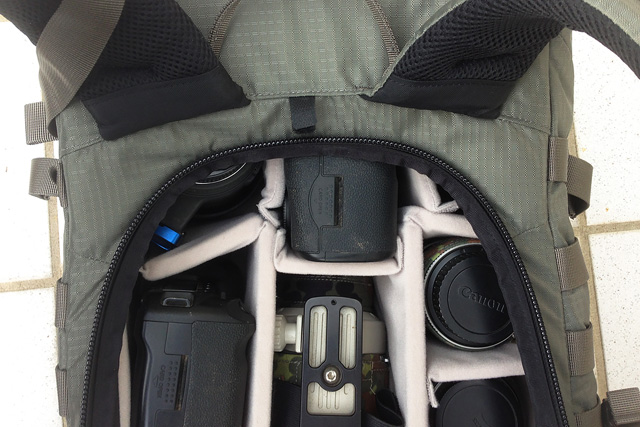
The XL Pro ICU is higher than the opening. Therefore it may be difficult to access the topmost items. To do that you may need to take out the lower items first. (Click to enlarge.)
If smaller ICU are used, only one can be attached because the position of the velcro strips in the second one doesn't correspond to the position of the loops inside Satori EXP. To me this looks like a design flaw that may be corrected in future, but I have to live with it in my copy of Satori EXP. Therefore the upper ICU has to be put free on top of the first. Since the depth of Shallow ICU is smaller than of the bag, the upper one that is not attached tends to slip towards the front side of Satori EXP when it isn't completely filled and some space at the front side is remaining. Shallow ICU have no support from the front side, and you have to fill the backpack completely to prevent them falling inside every time when you put the bag horizontally and open it.
The next picture shows Satori EXP with Medium Shallow and Small Shallow ICU inserted — that contain my equipment sets for landcape and macro photography.
The Shallow Small ICU is really small. As shown in the picture below, I typically would put the lens kit — 18mm, 24mm tilt-shift, 35mm, 85mm — into it that I use for landscape photography. No place for anything else would remain after that. The camera will have to be carried somewhere else.
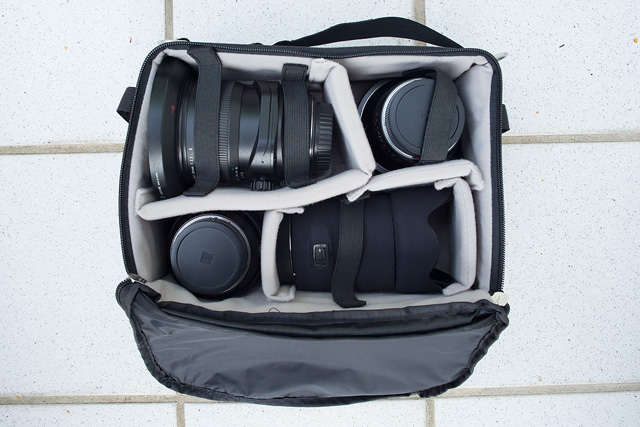
My usual landscape photography set of 4 lenses in a Small Shallow ICU. There is no place left for a camera body. (Click to enlarge.)
Alternatively these lenses can go into the Medium Shallow ICU. Then also the camera can be there. However, I use this ICU for the macro and close-up photography equipment: a camera, twin flash, angle viewfinder, lenses — 150 mm, 25mm, 15mm — and a 2x teleconverter. This set is shown in the picture below.
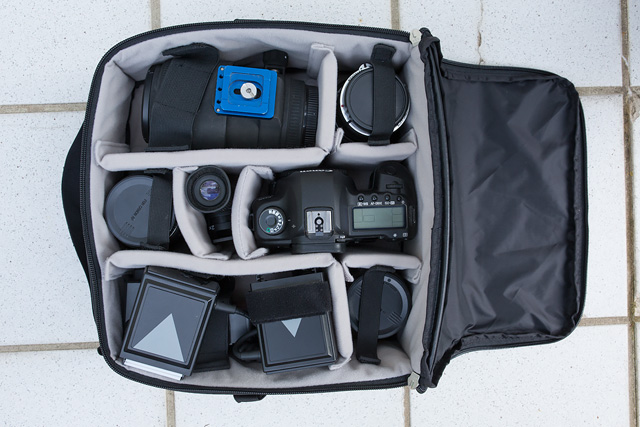
Here is my usual equipment for macro and close-up photography in a Medium Shallow ICU. (Click to enlarge.)
The soft pads that are inside the lids when the ICU are used separately from the bag have to be removed when the ICUs are in the bag. There should be a place for them in the bag. With current design, you just pull them out of the lid before inserting the ICU in Satori EXP and need to find a place for them inside — for instance to put them into to the notebook compartment when no notebook is there. Some kind of fixation for unused, opened lids of ICU would be nice to have, when the ICU are installed in the bag, or the lids should then be completely removable together with the pads.
The notebook compartment is huge and occupies all the empty space between the ICU and the front wall of the backpack. It would easy accommodate a 18-inch portable computer. I can't imagine that many outdoor photographers would make use of this capacity because such a monster alone would weigh over 3kg. This is another issue in the design of Satori EXP that surprises me. It would make more sense to integrate compartments for smaller notebooks — 11", 13", 15" — into ICU of Pro series like they already did in Large L/T and Small L/T of Shallow series. Of course, such notebook compartments should be removable for those people who like me don't carry computers during shooting in wilderness.
To position the notebook compartment at the front wall of Satori EXP was another design flaw, in my opinion, because the backpack has to be put on this side when it is being opened. More than that, the water bladder pocket is between the notebook compartment and the ICU when they are inserted. If you would have a notebook inside it, when you'll be putting the backpack on the front side to open it, many kilos of gear and water will be lying on the notebook. It would be a miracle if your notebook would survive this without damages. Therefore, if you carry a notebook in Satori EXP, you have always to think of taking it out through the top opening before you lay the backpack and access the content of the ICU. This is why I would always seek a place for my 11" Macbook Air at the backside or inside the ICU, so that it always remains on top.
When the water bladder is filled and Pro ICU are inserted almost no space remains for a notebook in the compartment anyway. It is always the case when my water bladder — Platypus Insulator 3l — is inside. Maybe there are narrower bladders that you can put along the side wall of Satori EXP and not to use the pocket. When I am in the field in hot regions I need much water. Therefore, a 3l bladder is just right for me although I almost never fill it with water completely.
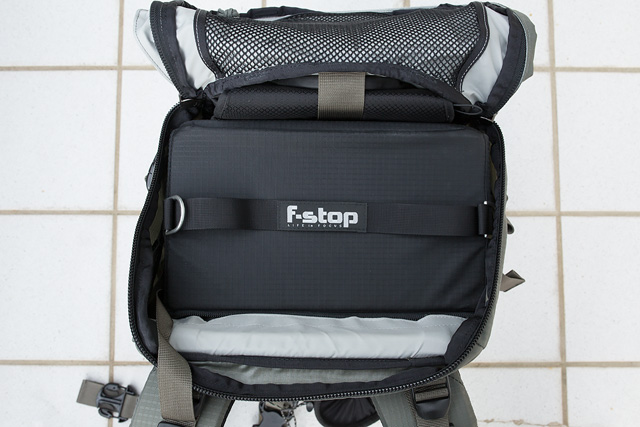
A XL Pro ICU and a hydration bladder are in Satori EXP, and no more space is remaining - not even for a notebook. The XL ICU reaches almost to the top of the backpack, so that you can't put much else under the top lid too. (Click to enlarge.)
When Satori EXP is used with XL Pro ICU, almost no space remains inside. Even if you don't need it for a 18-inch notebook, you can put almost nothing between the hydration bladder and the ICU. (See the picture above.) Very little space also remains on top of backpack — maybe enough just for something compact, such as a snack, a binocular, or similar.
It looks much better when Shallow ICU are used. This frees a couple of litres more inside Satori EXP that you can fill with cloths and more photographic and outdoor gear. (See the next two pictures below.)
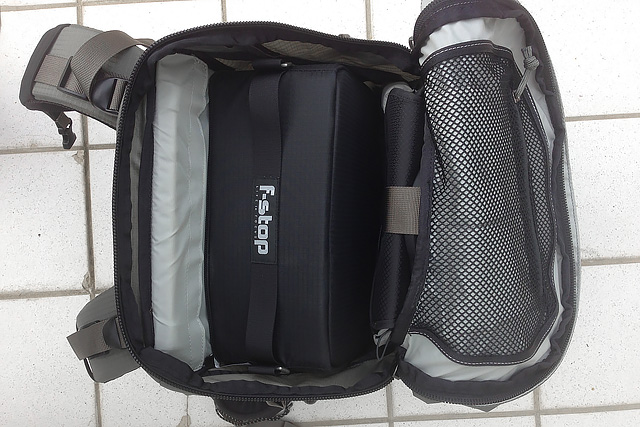
With Shallow ICU there is a little more space between the hydration compartment and the ICU but also not much. (Click to enlarge.)
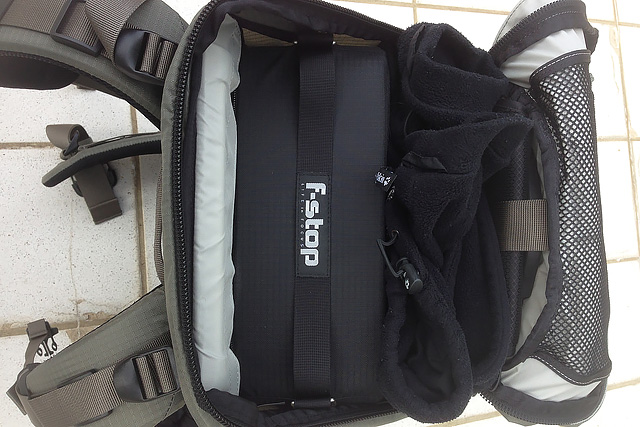
If you are using Shallow ICU, you can put at least something else into Satori EXP - for example, a fleece jacket. (Click to enlarge.)
Although the products of F-stop Gear (as actually so much else today) are being manufactured in China, their quality is very good. In my Satori EXP, when it was new, every detail was faultless, and I hope that it will remain so.
If I'd leave aside the conceptual deficits that were discussed above, I'd would acknowledge that this backpack is very beautiful and really nice to use. It has a very nice shape and fits my back better than any other backpacks I own or have owned before. Currently, F-Stop Gear offers the backpacks of Mountain series in 3 different colours (see the picture below).
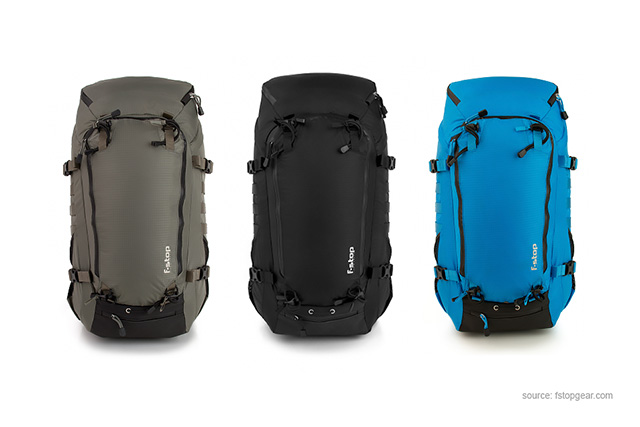
The Satori EXP backpacks are currently offered in 3 colours - foliage green, black and malibu blue. (Click to enlarge.)
Among these colour variants the “Malibu blue” looks extraordinary and very beautiful — too pity that it cannot be used by nature photographers who for obvious reasons need more discrete colouring.
Not to make this review much longer, I would omit the description of all features of Satori EXP and of materials used because the reader can find this information at the website of F-Stop Gear.
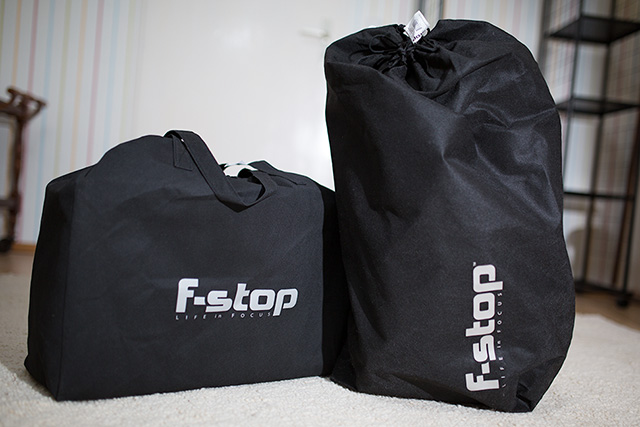
Every ICU and Satori EXP are delivered in nice bags that you can use either for storage of them or just as bags for anything else. (Click to enlarge.)
After I ordered my copy of Satori EXP in spring 2013, I had to wait for about 10 months till I got it delivered. Today it looks like F-stop Gear has improved its production capacities and made shipment time shorter. Most of their products are now constantly available for orders via their online shop. Currently, all orders appear to be shipped from outside the EU, hence the prices are here up-to 20% higher than in the U.S. — probably because customs duty and the European VAT are included. For the time of writing, the products of F-stop Gear weren't available in other parts of the world other than through direct orders from the U.S. If you live on other continents than North America and Europe, you may need to calculate the cost of purchasing Satori EXP and of a corresponding set of ICU carefully. Being a professional hi-tech backpack, it costs even in the U.S. and the EU more than bags of other manufacturers. The price may increase beyond making sense if you order it to be delivered elsewhere.
conclusions
Many outdoor photographers would be completely satisfied with the backpacks made by Clik Elite and Gura Gear and won't even consider F-Stop Gear as an option. Certainly, they will be right because the backpacks they are using are also excellent and may even completely meet their needs. However, except these two manufacturers I don't any other who would measure with F-Stop. Therefore, someone who is still has a backpack made by Lowepro or Tamrac and who would be ready to spend a hundred or two of dollars or euros more for a better bag should be advised to take look at F-Stop Gear products — Satori EXP, Tilopa BC or Loca. It particularly makes sense if you are a nature photographer and therefore got used to huge expenses anyway.
If not the issues that I criticised in this review, Satori EXP would be for me a perfect backpack of a nature photographer. Unfortunately, it is currently a mix between transport and field rucksack — an idea that I don't share. Making two different backpack models for each of these two concepts would be better.
I would prefer a bigger backpack — with size and volume of a typical trekking rucksack — even if it would exceed the airline limits. I don't see any reason for the entire backpack to be carried as hand luggage on airplane. It should be only the module — an ICU — that contains only fragile and expensive equipment items (such as camera bodies and lenses). The backpack itself can be checked in as main luggage. Even with this small Satori EXP I do it so.
